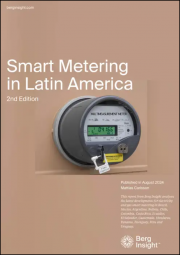Are you looking for detailed information and comprehensive data about the smart metering market in Latin America? The study concludes that the installed base of smart electricity meters in Latin America will grow at a compound annual growth rate (CAGR) of 20.5 percent throughout the forecast period, from 14.0 million in 2023 to 42.9 million in 2029. Get up to date with the latest information about vendors, products and local developments in each country.
Highlights from the report:
- In-depth market profiles of Brazil, Mexico, Argentina, Bolivia, Chile, Colombia, Costa Rica, Ecuador, El Salvador, Guatemala, Honduras, Panama, Paraguay, Peru and Uruguay.
- 360-degree overview of next-generation PLC, RF and cellular technologies for smart grid communications.
- Profiles of the key players in the smart metering industry in Latin America.
- New forecasts for smart electricity metering until 2029.
- Analysis of the latest market and industry developments in each of the countries.
- Case studies of smart metering projects by the leading energy groups.
Table of Contents
Table of Contents
List of Figures
Executive Summary
1. Smart Metering Solutions
- 1.1. Introduction to smart grids
- 1.2. Smart metering
- 1.2.1. Smart metering applications
- 1.2.2. Smart metering infrastructure
- 1.2.3. Benefits of smart metering
- 1.3. Project strategies
- 1.3.1. System design and sourcing
- 1.3.2. Rollout and integration
- 1.3.3. Implementation and operation
- 1.3.4. Communication with customers
- 1.4. Regulatory issues
- 1.4.1. Models for the introduction of smart meters
- 1.4.2. Standardisation
- 1.4.3. Individual rights issues
2. IoT Networks and Communications Technologies
- 2.1. IoT network technologies
- 2.1.1. Network architectures
- 2.1.2. Unlicensed and licensed frequency bands
- 2.2. PLC technology and standards
- 2.2.1. International standards organisations
- 2.2.2. G3-PLC
- 2.2.3. PRIME
- 2.2.4. Meters & More
- 2.3 3GPP cellular and LPWA technologies
- 2.3.1 2G/3G/4G/5G cellular technologies and IoT
- 2.3.2. NB-IoT and LTE-M
- 2.3.3. The role of cellular networks in smart meter communications
- 2.3.4. LoRa and LoRaWAN
- 2.3.5. Sigfox
- 2.4. IEEE 802.15.4-based RF
- 2.4.1. IEEE 802.15.4
- 2.4.2. Wi-SUN
- 2.4.3. Proprietary IPv6 connectivity stacks based on 802.15.4
3. Smart Metering Industry Players
- 3.1. Meter vendors
- 3.1.1. Itron
- 3.1.2. Landis+Gyr
- 3.1.3. Aclara (Hubbell)
- 3.1.4. Elgama Elektronika (Linyang Energy)
- 3.1.5. Gridspertise
- 3.1.6. Hexing Electrical
- 3.1.7. Holley Technology
- 3.1.8. Honeywell (Elster)
- 3.1.9. Iskraemeco
- 3.1.10. Kaifa Technology
- 3.1.11. Networked Energy Services
- 3.1.12. Sagemcom
- 3.1.13. Sanxing Electric (Nansen)
- 3.1.14. Wasion
- 3.1.15. WEG Group
- 3.1.16. ZIV
- 3.2. Communications solution providers
- 3.2.1 4RF
- 3.2.2. Corinex
- 3.2.3. Tantalus Systems
- 3.2.4. Trilliant
- 3.3. Software solution providers
- 3.3.1. Fluentgrid
- 3.3.2. Harris Utilities
- 3.3.3. Indra
- 3.3.4. Neoris
- 3.3.5. SAP
- 3.3.6. Siemens
- 3.4. System integrators and communications service providers
- 3.4.1. Accenture
- 3.4.2. America Movil
- 3.4.3. Ativa Solucoes
- 3.4.4. CAS Tecnologia
- 3.4.5. Cisco
- 3.4.6. IBM
- 3.4.7. NTT
- 3.4.8. Telefonica
- 3.4.9. Telecom Italia (TIM)
- 3.4.10. Tropico
4. Market Profiles
- 4.1. Regional summary
- 4.2. Argentina
- 4.2.1. Electricity and gas utility industry structure
- 4.2.2. Metering regulatory environment and smart metering market developments
- 4.3. Bolivia
- 4.3.1. Electricity utility industry infrastructure
- 4.3.2. Metering regulatory environment and smart metering market developments
- 4.4. Brazil
- 4.4.1. Electricity and gas utility industry structure
- 4.4.2. Metering regulatory environment and smart metering market developments
- 4.5. Chile
- 4.5.1. Electricity and gas utility industry structure
- 4.5.2. Metering regulatory environment and smart metering market developments
- 4.6. Colombia
- 4.6.1. Electricity and gas utility industry structure
- 4.6.2. Metering regulatory environment and smart metering market developments
- 4.7. Costa Rica
- 4.7.1. Electricity utility industry structure
- 4.7.2. Metering regulatory environment and smart metering market developments
- 4.8. Ecuador
- 4.8.1. Electricity utility infrastructure
- 4.8.2. Metering regulatory environment and smart metering initiatives
- 4.9. El Salvador
- 4.9.1. Electricity utility industry structure
- 4.9.2. Metering regulatory environment and smart metering market developments
- 4.10. Guatemala
- 4.10.1. Electricity utility infrastructure
- 4.10.2. Metering regulatory environment and smart metering market developments
- 4.11. Honduras
- 4.11.1. Electricity and gas utility industry structure
- 4.11.2. Smart metering market developments
- 4.12. Mexico
- 4.12.1. Electricity and gas utility industry structure
- 4.12.2. Metering regulatory environment and smart metering market developments
- 4.13. Panama
- 4.13.1. Electricity utility industry structure
- 4.13.2. Metering regulatory environment and smart metering market developments
- 4.14. Paraguay
- 4.14.1. Electricity utility infrastructure
- 4.14.2. Metering regulatory environment and smart metering initiatives
- 4.15. Peru
- 4.15.1. Electricity and gas utility industry structure
- 4.15.2. Metering regulatory environment and smart metering market developments
- 4.16. Uruguay
- 4.16.1. Electricity and gas utility industry structure
- 4.16.2. Metering regulatory environment and smart metering market developments
5. Market Analysis
- 5.1. Smart electricity metering
- 5.2. Market forecasts
- 5.2.1. Argentina
- 5.2.2. Bolivia
- 5.2.3. Brazil
- 5.2.4. Chile
- 5.2.5. Colombia
- 5.2.6. Costa Rica
- 5.2.7. Ecuador
- 5.2.8. El Salvador
- 5.2.9. Guatemala
- 5.2.10. Honduras
- 5.2.11. Mexico
- 5.2.12. Panama
- 5.2.13. Paraguay
- 5.2.14. Peru
- 5.2.15. Uruguay
- 5.3. Industry analysis and technology trends
- 5.3.1. Technology vendors
- 5.3.2. Technology trends
- 5.4. Smart gas metering
6. Case Studies
- 6.1. Copel
- 6.2. Grupo ICE
- 6.3. Light
- 6.4. UTE
- List of Acronyms and Abbreviations
